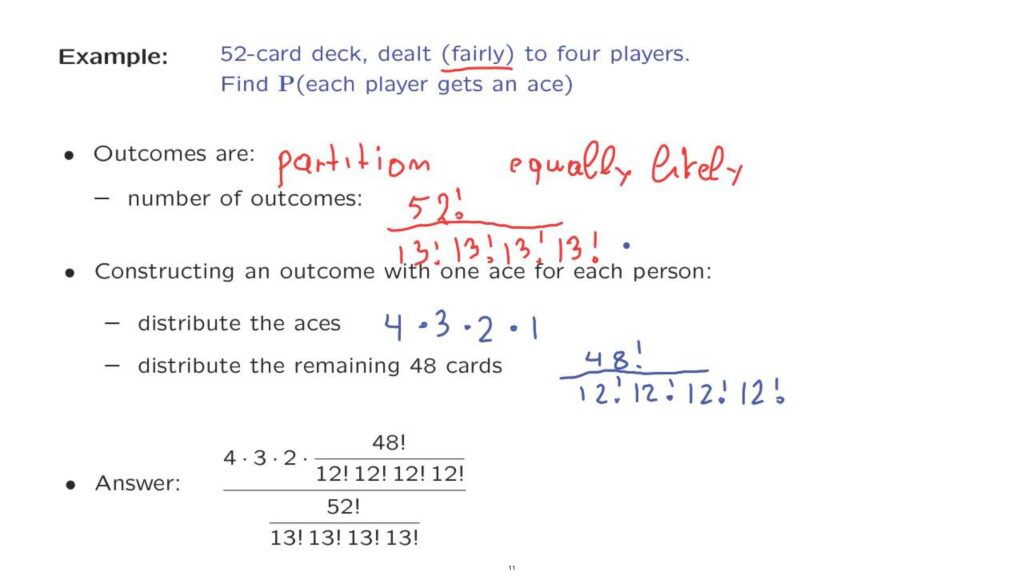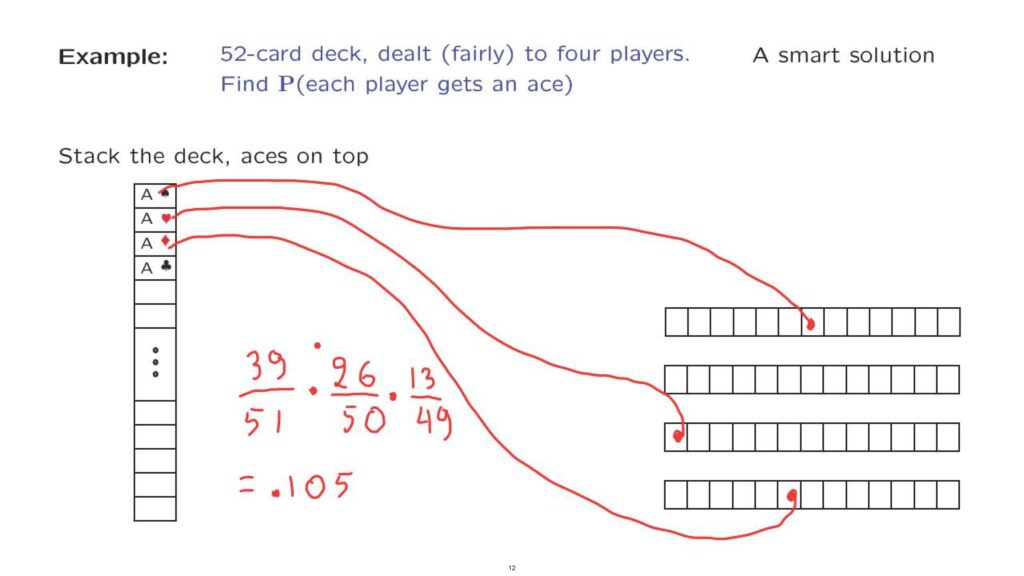We will now apply our multinomial formula for counting the number of partitions to solve the following probability problem.
We have a standard 52-card deck, which we deal to four persons.
Each person gets 13 cards as, for example, in bridge.
What is the probability that each person gets exactly one ace? Well, before we start, as always we will need a probability model.
We deal the cards fairly, and this is going to be our model.
But we still need to interpret our statement.
To give this interpretation, let us first think of the outcomes of the experiment.
What are the possible outcomes? An outcome of this experiment is a partition of the 52 cards into the four persons so that each person gets exactly 13 cards.

Our statement about dealing the cards fairly will be an assumption that all partitions are equally likely.
So since all partitions, all outcomes of the experiment, are equally likely, this means that we can solve a probability question by counting.
We need to count the number of elements of our sample space, the number of possible outcomes, and then count the number of outcomes that make the event of interest to occur.
Let us start with the number of elements of the sample space.
This is the problem that we just dealt with a little while ago– the number of outcomes, the number of partitions of 52 items into four persons, where we give 13 cards to person one, 13 cards to person two, 13 cards to person three, and 13 cards to person four.
The number of possible ways of doing this is equal to this multinomial coefficient.
So now let us count the number of outcomes that belong to the event of interest, namely the outcomes where each person gets an ace.
We think of the process of constructing such an outcome as a multi-stage process.
And we count the number of choices that we have at each stage.
The process is as follows.
We first distribute the four aces.
We take the ace of spades and give it to one person.
In how many ways can we do it? We can do it in four ways.
Then we take the next ace.
The next ace must be given to a different person.
And so at that stage, we have three different choices about who to give that ace to.
Then we consider the next ace.
At this point, two persons already have aces.

So we have two available choices for who can get the next ace.
And finally for the last ace, we do not have any choice.
We give it to the only remaining person who doesn’t yet have an ace.
Having distributed the four aces, then we need to somehow distribute the remaining 48 cards to the four people.
But we can do that in any way we want.
So all we need to do is to just partition the 48 cards into four subsets of given cardinalities.
And this can be done by a number of ways, which is the number of such partitions.
We have already found what that number is.
And it is this particular multinomial coefficient.
So the number of ways that we can distribute the cards so that each person gets an ace, according to the counting principle, is going to be the number of ways that we can distribute the aces times the number of ways that we can distribute the remaining cards.

The product of this number gives us the count, gives us the cardinality, of the event of interest.
We also have the cardinality of the sample space.
So the desired probability can be found by dividing these two numbers.
And the final answer takes this form.
Let us now look at the same problem but in a different way.
Probability problems can often be solved in multiple ways.
And some can be faster than others.
So we want to look for a smarter solution that perhaps will get us in a faster way to the desired answer.
We will use the following trick.
We will think about a very specific way of dealing the cards which is the following.
We take the 52 cards, the card deck, and stack it so that the four aces are at the top.
So they are first.

And then we deal those cards to the players as follows.
We think of each player having 13 slots of his own.
And the cards will be placed randomly into the different slots.
So we can do this one card at a time, starting from the top.
We take the first ace and send it to a random location.
Then we will take the second ace, send it to a random location, and so on.
What we want to calculate is the probability that the four aces will end up in locations or in slots that are associated with different persons.
So let us calculate this probability.
The first ace can go anywhere.
It doesn’t matter.
For the second ace, it has 51 slots to choose from.
It’s 51 because we started with 52, but one slot has already been taken by that particular ace.
So for the ace of hearts, we have 51 slots that it can go to.
And out of those 51, we have 39 of them that belong to people who do not yet have an ace.
So this is the probability that the ace of hearts gets placed into a slot that belongs to a person who is different than the person who got the first ace.
Now let us consider this ace.
What is the probability that this ace will get into a slot which belongs to either this person or that person? It has 26 slots in which this desired event is going to happen.
And it’s 26 out of the 50 available slots.
Finally, let us consider this ace.
So having placed that ace and assuming that it got to a different person, what is the probability now that this ace is going to go to this person who doesn’t yet have one? The probability of this happening is the number of slots associated with that person, which is equal to 13 divided by the number of slots that this card can choose from.

And the number of slots is 52 minus the 3 slots that have already been taken, so it’s 49.
And so this is the answer to our problem.
This expression looks very different from the expression that we derived a little earlier.
But you can do the algebra, the arithmetic, simplify the answer, and you will verify that indeed it’s exactly the same answer.
And in case you’re curious, the numerical value turns out to be 0.105.
So there’s about 10% [chance] that when you deal the cards in bridge, each one of the players is going to end up having exactly one ace.
So this was a faster way of getting to the answer to our problem, compared to the previous one.
But it raises a legitimate question.

Is the way that we dealt the cards by putting the aces on top and then dealing them, is that way a fair way of dealing the cards? Is it true that with this way of dealing the cards all partitions are equally likely? It turns out that this is indeed the case.
But it does require a bit of thinking.
Maybe you can see it intuitively that this is the case.
But if not, then it is something that one can prove.
It can be proved formally as follows.
One first needs to check that all permutations, that is all possible allocations of cards into slots, are equally likely.
And because of this, one can then argue that any possible partition into subsets of [13] is also equally likely.
So this is an equivalent way of dealing the cards to the one that we considered earlier, which was that every partition is equally likely.
Therefore, we did indeed solve the same problem, and so this is a legitimate alternative way of getting to the answer.
And of course, it’s reassuring to check that this numerical expression agrees with the numerical expression we had derived earlier.